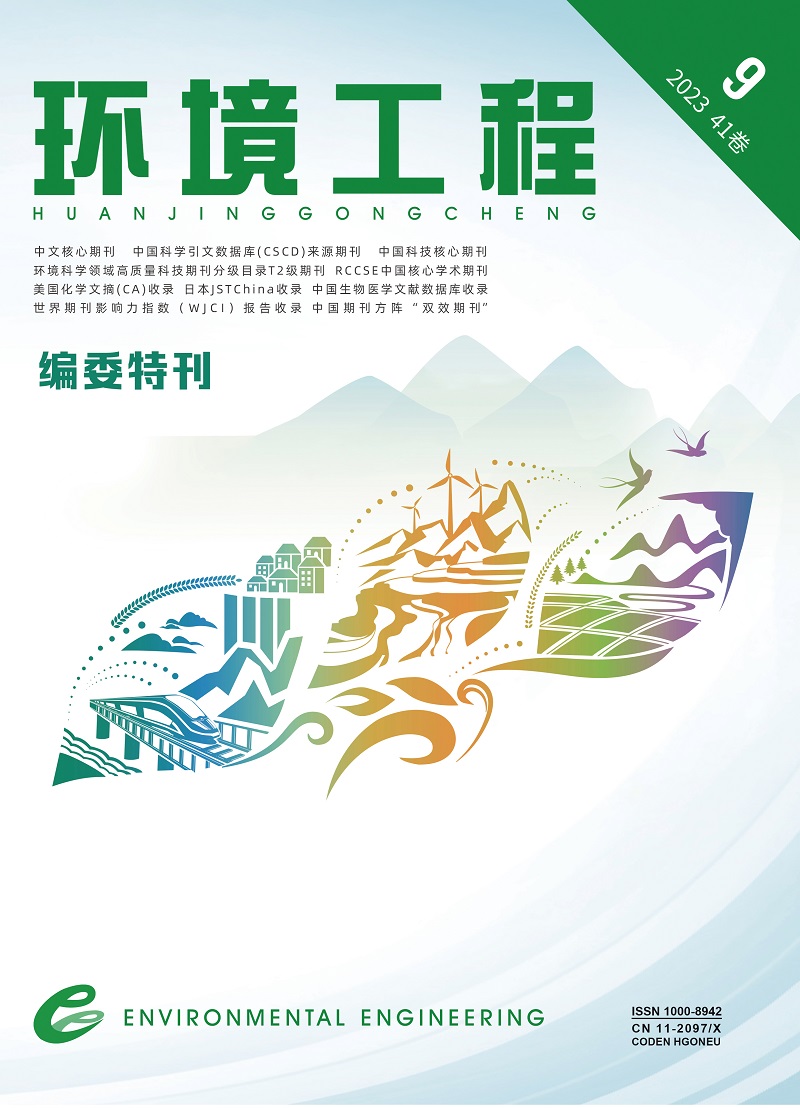| [1] |
CALDERON A G, DUAN H, MENG J, et al. An integrated strategy to enhance performance of anaerobic digestion of waste activated sludge[J]. Water Research, 2021, 195:116977.
|
| [2] |
SHI Z, CAMPANARO S, USMAN M, et al. Genome-centric metatranscriptomics analysis reveals the role of hydrochar in anaerobic digestion of waste activated sludge[J]. Environmental Science & Technology, 2021, 55(12):8351-8361.
|
| [3] |
LI Y, CHEN Z, PENG Y, et al. Deeper insights into the effects of substrate to inoculum ratio selection on the relationship of kinetic parameters, microbial communities, and key metabolic pathways during the anaerobic digestion of food waste[J]. Water Reserach, 2022, 217:118440.
|
| [4] |
赵刚, 唐建国, 徐竟成, 等. 中美典型污泥处理处置工程能耗和碳排放比较分析[J]. 环境工程, 2022, 40(12):9-16.
|
| [5] |
RAJAGOPAL R, MASSÉ D I, SINGH G. A critical review on inhibition of anaerobic digestion process by excess ammonia[J]. Bioresource Technology, 2013, 143:632-641.
|
| [6] |
JIANG Y, MCADAM E, ZHANG Y, et al. Ammonia inhibition and toxicity in anaerobic digestion:a critical review[J]. Journal of Water Process Engineering, 2019, 32:100899.
|
| [7] |
WANG Z, JIANG Y, WANG S, et al. Impact of total solids content on anaerobic co-digestion of pig manure and food waste:insights into shifting of the methanogenic pathway[J]. Waste Management, 2020, 114:96-106.
|
| [8] |
何仕均, 王建龙, 赵璇. 氨氮对厌氧颗粒污泥产甲烷活性的影响[J]. 清华大学学报(自然科学版), 2005, 9(45):1294-1296.
|
| [9] |
LIU C, HUANG H, DUAN X, et al. Integrated metagenomic and metaproteomic analyses unravel ammonia toxicity to active methanogens and syntrophs, enzyme synthesis, and key enzymes in anaerobic digestion[J]. Environmental Science & Technology, 2021, 55(21):14817-14827.
|
| [10] |
ZHANG H, YUAN W, DONG Q, et al. Integrated multi-omics analyses reveal the key microbial phylotypes affecting anaerobic digestion performance under ammonia stress[J]. Water Research, 2022, 213:118152.
|
| [11] |
LIU Y, NGO H H, GUO W, et al. The roles of free ammonia (FA) in biological wastewater treatment processes:a review[J]. Environment International, 2019, 123:10-19.
|
| [12] |
SAHA S, BASAK B, HWANG J H, et al. Microbial symbiosis:a network towards biomethanation[J]. Trends in Microbiology, 2020, 28(12):968-984.
|
| [13] |
CARBALLA M, REGUEIRO L, LEMA J M. Microbial management of anaerobic digestion:exploiting the microbiome-functionality nexus[J]. Current Opinion in Biotechnology, 2015, 33:103-111.
|
| [14] |
SIEBER J R, MCINERNEY M J, GUNSALUS R P. Genomic insights into syntrophy:the paradigm for anaerobic metabolic cooperation[J]. Annual Review of Microbiology, 2012, 66:429-452.
|
| [15] |
SPROTT G D, PATEL G B. Ammonia toxicity in pure cultures of methanogenic bacteria[J]. Systematic and Applied Microbiology, 1986, 7(2/3):358-363.
|
| [16] |
FOTIDIS I A, KARAKASHEV D, ANGELIDAKI I. The dominant acetate degradation pathway/methanogenic composition in full-scale anaerobic digesters operating under different ammonia levels[J]. International Journal of Environmental Science and Technology, 2013, 11(7):2087-2094.
|
| [17] |
WANG Z, WANG S, HU Y, et al. Distinguishing responses of acetoclastic and hydrogenotrophic methanogens to ammonia stress in mesophilic mixed cultures[J]. Water Research, 2022, 224:119029.
|
| [18] |
LV Z, LEITE A F, HARMS H, et al. Microbial community shifts in biogas reactors upon complete or partial ammonia inhibition[J]. Applied Microbiology and Biotechnology, 2019, 103(1):519-533.
|
| [19] |
RUIZ-SANCHEZ J, CAMPANARO S, GUIVERNAU M, et al. Effect of ammonia on the active microbiome and metagenome from stable full-cale digesters[J]. Bioresource Technology, 2018, 250:513-522.
|
| [20] |
CHEN H, WANG W, XUE L, et al. Effects of ammonia on anaerobic digestion of food waste:process performance and microbial community[J]. Energy & Fuels, 2016, 30(7):5749-5757.
|
| [21] |
CHRISTOU M L, VASILEIADIS S, KALAMARAS S D, et al. Ammonia-induced inhibition of manure-based continuous biomethanation process under different organic loading rates and associated microbial community dynamics[J]. Bioresource Technology, 2021, 320:124323.
|
| [22] |
HE L, YU J, LIN Z, et al. Organic matter removal performance, pathway and microbial community succession during the construction of high-ammonia anaerobic biosystems treating anaerobic digestate food waste effluent[J]. Journal of Environmental Management, 2022, 317:115428.
|
| [23] |
彭韵, 李蕾, 伍迪, 等. 微生物群落对氨胁迫响应的宏基因组学研究[J]. 中国环境科学, 2022, 42(2):777-786.
|
| [24] |
CALLI B, MERTOGLU B, INANC B, et al. Effects of high free ammonia concentrations on the performances of anaerobic bioreactors[J]. Process Biochemistry, 2005, 40(3/4):1285-1292.
|
| [25] |
ZHANG C, YUAN Q, LU Y. Inhibitory effects of ammonia on syntrophic propionate oxidation in anaerobic digester sludge[J]. Water Research, 2018, 146:275-287.
|
| [26] |
PENG X, ZHANG S, LI L, et al. Long-term high-solids anaerobic digestion of food waste:effects of ammonia on process performance and microbial community[J]. Bioresource Technology, 2018, 262:148-158.
|
| [27] |
ZHANG H, PENG Y, YANG P, et al. Response of process performance and microbial community to ammonia stress in series batch experiments[J]. Bioresource Technology, 2020, 314:123768.
|
| [28] |
YE M, ZHU A, SUN B, et al. Methanogenic treatment of dairy product wastewater by thermophilic anaerobic membrane bioreactor:ammonia inhibition and microbial community[J]. Bioresource Technology, 2022, 357:127349.
|
| [29] |
MLINAR S, WEIG A R, FREITAG R. Influence of NH3 and NH4+ on anaerobic digestion and microbial population structure at increasing total ammonia nitrogen concentrations[J]. Bioresource Technology, 2022, 361:127638.
|
| [30] |
CYPIONKA H, WIDDEL F, PFENNIG N. Survival of sulfate-reducing bacteria after oxygen stress, and growth in sulfate-free oxygen-sulfide gradients[J]. FEMS microbiology ecology, 1985, 1(1):39-45.
|
| [31] |
BOONE D R, BRYANT M P. Propionate-degrading bacterium, Syntrophobacter wolinii sp. nov. gen. nov., from methanogenic ecosystems[J]. Applied and Environmental Microbiology, 1980, 40(3):626-632.
|
| [32] |
DWYER D F, WEEG-AERSSENS E, SHELTON D R, et al. Bioenergetic conditions of butyrate metabolism by a syntrophic, anaerobic bacterium in coculture with hydrogen-oxidizing methanogenic and sulfidogenic bacteria[J]. Applied and Environmental Microbiology, 1988, 54(6):1354-1359.
|
| [33] |
LIU C, ZHANG X, CHEN C, et al. Physiological responses of Methanosarcina barkeri under ammonia stress at the molecular level:the unignorable lipid reprogramming[J]. Environmental Science & Technology, 2023, 57(9):3917-3929.
|
| [34] |
MCNEIL P L, STEINHARDT R A. Loss, restoration, and maintenance of plasma membrane integrity[J]. The Journal of Cell Biology, 1997, 137(1):1-4.
|
| [35] |
CALLI B, MERTOGLU B, INANC B, et al. Methanogenic diversity in anaerobic bioreactors under extremely high ammonia levels[J]. Enzyme and Microbial Technology, 2005, 37(4):448-455.
|
| [36] |
CALLI B, MERTOGLU B, INANC B, et al. Community changes during start-up in methanogenic bioreactors exposed to increasing levels of ammonia[J]. Environmental Technology, 2005, 26(1):85-91.
|
| [37] |
JEYENDRAN R, VAN DER VEN H, PEREZ-PELAEZ M, et al. Development of an assay to assess the functional integrity of the human sperm membrane and its relationship to other semen characteristics[J]. Reproduction, 1984, 70(1):219-228.
|
| [38] |
ROY S, MONDAL A, YADAV V, et al. Mechanistic insight into the antibacterial activity of chitosan exfoliated MoS2 nanosheets:membrane damage, metabolic inactivation, and oxidative stress[J]. ACS Applied Bio Materials, 2019, 2(7):2738-2755.
|
| [39] |
SCHNAIDER L, BRAHMACHARI S, SCHMIDT N W, et al. Self-assembling dipeptide antibacterial nanostructures with membrane disrupting activity[J]. Nature Communication, 2017, 8(1):1365.
|
| [40] |
PENG Y, LI L, YANG P, et al. Integrated genome-centric metagenomic and metaproteomic analyses unravel the responses of the microbial community to ammonia stress[J]. Water Research, 2023, 242:120239.
|
| [41] |
PADMAKUMAR R, PADMAKUMAR R, BANERJEE R. Evidence that cobalt-carbon bond homolysis is coupled to hydrogen atom abstraction from substrate in methylmalonyl-CoA mutase[J]. Biochemistry, 1997, 36(12):3713-3718.
|
| [42] |
WEBSTER M W, TAKACS M, ZHU C, et al. Structural basis of transcription-translation coupling and collision in bacteria[J]. Science, 2020, 369(6509):1355-1359.
|
| [43] |
KORKHIN Y, UNLIGIL U M, LITTLEFIELD O, et al. Evolution of complex RNA polymerases:the complete archaeal RNA polymerase structure[J]. PLoS Biology, 2009, 7(5):e1000102.
|
| [44] |
YUSUPOV M M, YUSUPOVA G Z, BAUCOM A, et al. Crystal structure of the ribosome at 5.5Å resolution[J]. Science, 2001, 292(5518):883-896.
|
| [45] |
SCHMEING T M, VOORHEES R M, KELLEY A C, et al. The crystal structure of the ribosome bound to EF-Tu and aminoacyl-tRNA[J]. Science, 2009, 326(5953):688-694.
|
| [46] |
KAYHANIAN M. Ammonia inhibition in high-solids biogasification:an overview and practical solutions[J]. Environmental Technology, 1999, 20(4):355-365.
|
| [47] |
FERREIRA T, CARRONDO M, ALVES P. Effect of ammonia production on intracellular pH:consequent effect on adenovirus vector production[J]. Journal of Biotechnology, 2007, 129(3):433-438.
|
| [48] |
SPROTT G D, SHAW K M, JARRELL K F. Ammonia/potassium exchange in methanogenic bacteria[J]. Journal of Biological Chemistry, 1984, 259(20):12602-12608.
|
| [49] |
WITTMANN C, ZENG A P, DECKWER W D. Growth inhibition by ammonia and use of a pH-controlled feeding strategy for the effective cultivation of Mycobacterium chlorophenolicum[J]. Applied Microbiology and Biotechnology, 1995, 44(3):519-525.
|
| [50] |
KUHNER C, DRAKE H, ALM E, et al. Methane production and oxidation by soils from acidic forest wetlands of east-central Germany[C]//Abstr 96th Gen Meet Am Soc Microbiol American Society for Microbiology. Washington, DC, 1996:304.
|
| [51] |
LLOYD C T, IWIG D F, WANG B, et al. Discovery, structure and mechanism of a tetraether lipid synthase[J]. Nature, 2022, 609(7925):197-203.
|
| [52] |
HARAYAMA T, RIEZMAN H. Understanding the diversity of membrane lipid composition[J]. Nature Reviews Molecular Cell Biology, 2018, 19(5):281-296.
|
| [53] |
LOPEZ-LARA I M, GEIGER O. Bacterial lipid diversity[J]. Biochimica et biophysica acta:molecular and cell biology of lipids, 2017, 1862(11):1287-1299.
|
| [54] |
QI Z, SUN N, LIU C. Glyoxylate cycle maintains the metabolic homeostasis of Pseudomonas aeruginosa in viable but nonculturable state induced by chlorine stress[J]. Microbiological Research, 2023, 270:127341.
|
| [55] |
BALLWEG S, SEZGIN E, DOKTOROVA M, et al. Regulation of lipid saturation without sensing membrane fluidity[J]. Nature Communinations, 2020, 11(1):756.
|
| [56] |
LI R, GUINEY L M, CHANG C H, et al. Surface oxidation of graphene oxide determines membrane damage, lipid peroxidation, and cytotoxicity in macrophages in a pulmonary toxicity model[J]. ACS Nano, 2018, 12(2):1390-1402.
|
| [57] |
SHANTA P V, LI B, STUART D D, et al. Lipidomic profiling of algae with microarray MALDI-MS toward ecotoxicological monitoring of herbicide exposure[J]. Environmental Science & Technology, 2021, 55(15):10558-10568.
|
| [58] |
MARQUENO A, BLANCO M, MACEDA-VEIGA A, et al. Skeletal muscle lipidomics as a new tool to determine altered lipid homeostasis in fish exposed to urban and industrial wastewaters[J]. Environmental Science Technology, 2019, 53(14):8416-8425.
|
| [59] |
TANIGUCHI M, OKAZAKI T. The role of sphingomyelin and sphingomyelin synthases in cell death, proliferation and migration-from cell and animal models to human disorders[J]. Biochimica Biophysica Acta, Mol. Cell Biology Lipids, 2014, 1841(5):692-703.
|
| [60] |
TANIGUCHI M, OKAZAKI T. Role of ceramide/sphingomyelin (SM) balance regulated through "SM cycle" in cancer[J]. Cell Signalling, 2021, 87:110119.
|
| [61] |
YANG P, PENG Y, LIU H, et al. Multi-scale analysis of the foaming mechanism in anaerobic digestion of food waste:from physicochemical parameter, microbial community to metabolite response[J]. Water Research, 2022, 218:118482.
|


 Login
Login Register
Register E-alert
E-alert






 DownLoad:
DownLoad: